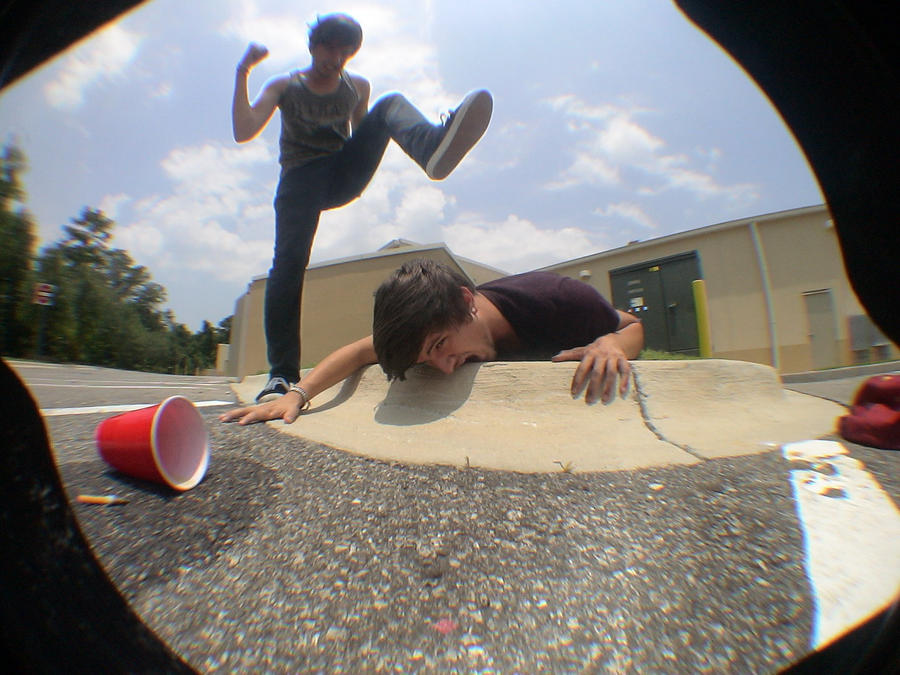Curb Stomp: The Controversial Technique Explained | Risks & Legality
Is the "curb stomp" a legitimate self-defense tactic, or does it represent a dangerous descent into brutality? The answer, as we will discover, is not a simple one.
The concept of the "curb stomp" has, for better or worse, become ingrained in the cultural consciousness, largely due to its frequent and often graphic portrayal in film and media. This move, characterized by striking a downed opponent's head, frequently with the heel or sole of a shoe, raises a multitude of complex questions about its place in martial arts, self-defense, and the legal framework surrounding the use of force. This article aims to meticulously dissect every facet of this controversial technique, providing a comprehensive understanding of its history, practical application, legal ramifications, and ethical considerations. We will navigate the complexities of its usage, explore its place in various combat disciplines, and examine its portrayal within the realm of popular culture.
| Term | Definition |
|---|---|
| Origins | The phrase "curb stomp" originated in the United States during the late 20th century, describing the act of stomping on a person's head while they are on the ground, typically with the heel of a shoe. |
| Technique | The move involves striking an opponent's head while they're on the ground. Variations can include a basic stomp, modified stomps, and ground-and-pound techniques. |
| Legality | Generally considered aggravated assault, the legality varies by jurisdiction. Excessive force can lead to severe legal repercussions. |
| Ethics | Raises significant ethical concerns about unnecessary violence. Martial arts communities emphasize discipline, respect, and control. |
| Martial Arts | Not a formal technique in traditional martial arts, but it has been studied. Some arts like Krav Maga and Muay Thai incorporate similar techniques. |
| Self-Defense | Highly controversial. Self-defense experts emphasize de-escalation and non-lethal methods. Curb stomping should be a last resort. |
| Combat Sports | Often depicted as a finishing move in MMA and professional wrestling. Regulated competitions prohibit dangerous techniques. |
| Media | Popularized by movies, TV shows, and video games. Media representations often downplay real-world consequences. |
| Health Risks | Significant health risks include concussions, fractures, brain damage, and death. Medical experts advocate for safer alternatives. |
The origins of the "curb stomp" are rooted in the gritty realities of street fights and self-defense situations, primarily within the United States. This brutal technique gained notoriety in the late 20th century, a period marked by evolving understandings of violence, both on the streets and in the media. The term itself quickly became a chilling shorthand for the act of stomping on someone's head while they are rendered defenseless on the ground, a strike often delivered with the heel or sole of a shoe. Its effectiveness in swiftly incapacitating an opponent made it a subject of interest, or at the very least, morbid fascination, among those who studied combat tactics. The move, however, has never been a formal component of traditional martial arts training. Nevertheless, its impact resonates through both the practical and the theoretical understanding of violence and its consequences.
- Priscilla Love Vanwinkle The Woman Behind The Van Winkle Bourbon Legacy
- Unlocking The Crossword Melon Like Tropical Fruit Its Papaya
One can trace the "curb stomp" to the origins of battlefield techniques, a dark echo of the ancient practice of delivering a final, decisive blow to a downed adversary. In those historical contexts, such actions might have been seen as practical necessities. Yet, when viewed through the lens of modern law and societal norms, these actions raise serious ethical and legal concerns. They highlight the essential tension between the need for self-preservation and the very real dangers of excessive force.
- Used in street fights and self-defense situations
- Influenced by martial arts and combat sports
- Popularized in movies and media
The application of the "curb stomp" is, in its essence, a brutal and direct demonstration of force. The technique itself, although seemingly simple, combines brute force with the advantages of leverage. The practitioner typically positions the heel or the sole of their shoe on the opponent's head, applying significant pressure. This action can inflict devastating injuries, including, but not limited to, concussions, skull fractures, traumatic brain injury, and in the worst-case scenarios, even death. Its simplicity, and the severe consequences that it can elicit, contribute to its notoriety.
Variations of the technique exist, adapted to different scenarios and, unfortunately, different levels of malicious intent.
- Is Mase Still A Pastor In 2024 His Dual Life Explored
- Sabrina Morrisseys Age Career A Deep Dive Into Her Life
- Basic Stomp: A straightforward strike to the head, employing the heel or sole of the shoe.
- Modified Stomp: Enhancing the force of the strike by using knees or elbows.
- Ground-and-Pound: Combining strikes with ground control techniques.
It is critical to emphasize the inherent danger of these techniques. Their use should, ideally, be restricted to the most extreme self-defense situations, if employed at all. The potential for irreversible injury or death, and the legal consequences they carry, make them anything but a casual option.
The legal implications of executing a "curb stomp" are, without exception, severe. The act is generally classified as aggravated assault, with the specific charges varying depending on jurisdiction. Many nations and legal systems emphasize the illegality of using excessive force against an individual who is rendered unconscious or defenseless. Consequently, those who employ such tactics face the very real prospect of criminal charges and potential imprisonment. The legal system carefully examines each case, specifically looking into self-defense claims and determining whether the level of force was both reasonable and necessary under the circumstances.
Court cases involving "curb stomping" have starkly highlighted the dangers of this technique and its potential to cause severe and long-term damage, or, tragically, even result in death. Legal professionals consistently emphasize the importance of proportionality in self-defense situations, where the force used must be carefully calibrated to the immediate threat. The law prioritizes the preservation of life and minimizes harm; therefore, the use of excessive or unnecessary force is strictly prohibited. This principle underlines the need to consider all available alternatives before resorting to any action that may inflict permanent harm.
- Use of excessive force
- Assault and battery charges
- Self-defense laws and limitations
From an ethical standpoint, the "curb stomp" is unequivocally problematic, raising difficult questions about the morality of using such a brutal method of inflicting harm. Some would suggest that the technique may have a place in self-defense scenarios, particularly when facing an immediate, life-threatening attack. However, many consider that it invariably crosses the line into gratuitous and unnecessary violence. Within the martial arts community in particular, where tenets of discipline, respect, and control are highly valued, the endorsement of such a technique is viewed with a degree of disdain. These principles place a premium on minimizing harm and de-escalating conflict whenever possible.
Many martial arts instructors discourage the use of this technique, teaching instead the value of more humane and controlled methods of neutralizing a threat. Ethical considerations also extend to the psychological impact of using such a move, not only on the victim but also on the individual administering the blow. The act itself, and the awareness of the permanent harm that may ensue, can have long-lasting and deeply negative effects on the attacker's psyche.
- Respect for opponents
- Control and discipline in combat
- Minimizing harm in self-defense
While "curb stomping" is not a formal technique within traditional martial arts disciplines, it has been studied and dissected within various combat systems. Certain martial arts, such as Krav Maga and Muay Thai, which emphasize practicality in self-defense, may incorporate similar ground-and-pound techniques. The intent in these systems is, however, to disable and incapacitate the attacker. However, the emphasis is still on using the minimum level of force necessary to control the situation.
In stark contrast, most martial arts schools actively discourage the use of the "curb stomp" due to its potential for causing severe and potentially fatal harm. Instead, these schools focus on imparting students with the skills to neutralize threats without resorting to excessive violence. They teach methods to de-escalate conflicts, the importance of situational awareness, and the application of appropriate levels of force based on the nature of the threat.
- Krav Maga: Emphasizes practical self-defense techniques
- Muay Thai: Incorporates ground-and-pound strategies
- Traditional Martial Arts: Focus on discipline and control
The application of "curb stomping" within a self-defense situation is inherently controversial. While it may offer a quick and effective way to incapacitate an attacker, it also carries significant risks and profound legal ramifications. Self-defense experts, therefore, consistently emphasize the importance of utilizing only the level of force needed to neutralize the threat. The objective should always be the safety and preservation of life.
Training in self-defense techniques should always focus on de-escalation strategies, cultivating situational awareness, and teaching non-lethal methods of neutralizing threats. The "curb stomp" should, therefore, only be considered as a last resort, reserved for the most extreme situations where the defender's life is demonstrably at risk. Such circumstances represent a clear and present danger, where all other alternatives have been exhausted.
- De-escalation techniques
- Situational awareness
- Non-lethal neutralization methods
In the world of combat sports, particularly in Mixed Martial Arts (MMA) and professional wrestling, "curb stomping" is often portrayed as a definitive finishing move. Despite this prominent media presence, it is not permitted in most regulated competitions. The primary reason for this is to ensure the safety of the athletes and to protect against the potential for serious injury.
Combat sports organizations prioritize safety and sportsmanship, and so they actively discourage the use of dangerous techniques like the "curb stomp". Fighters are meticulously trained to respect their opponents and to adhere to strict rules and regulations designed to minimize the risk of injury. This is a fundamental principle, as the focus remains on competition rather than inflicting gratuitous harm.
- MMA: Strict rules prohibiting dangerous moves
- Professional Wrestling: Entertainment-based depictions
- Regulated Competitions: Emphasis on safety and sportsmanship
The enduring portrayal of "curb stomping" within films, television shows, and video games has significantly contributed to its presence in popular culture. Scenes in iconic films, such as "Pulp Fiction," have immortalized the move, often presenting it as a brutal and efficient way to dispatch an opponent. This kind of media attention can have a powerful influence on cultural perception. However, it is essential to recognize that media representations of violence often downplay the real-world dangers and consequences.
It is imperative to distinguish between the fictional depictions, with their emphasis on dramatic effect, and the real-life applications of violence. Understanding the ethical, legal, and medical implications is critical to properly assessing the gravity of such actions. This distinction is crucial, and it helps to prevent the trivialization of violence and the potential for its harmful emulation.
- Movie and TV portrayals
- Video game representations
- Real-world vs. fictional depictions
The health risks associated with "curb stomping" are undeniably severe, ranging from concussions and fractures to permanent brain damage, and tragically, even death. Medical experts consistently emphasize the importance of avoiding dangerous techniques in combat situations, advocating for safer alternatives and prioritizing the preservation of life.
Training in combat sports and self-defense should always prioritize safety and injury prevention. Participants must be fully aware of the potential risks involved. Therefore, proper technique, the use of protective gear, and supervised training are essential components of safe combat practice, and they are emphasized at all levels.
- Avoid dangerous techniques
- Use protective gear
- Train under supervision
- Discover The Rise Of Jesus Lechuga Entertainment Icon
- Remembering Phil Harris The Deadliest Catch Legend His Legacy

Music Curb Stomp

Curb Stomp by Mr3baseboy on DeviantArt

Solo Sikoa v1